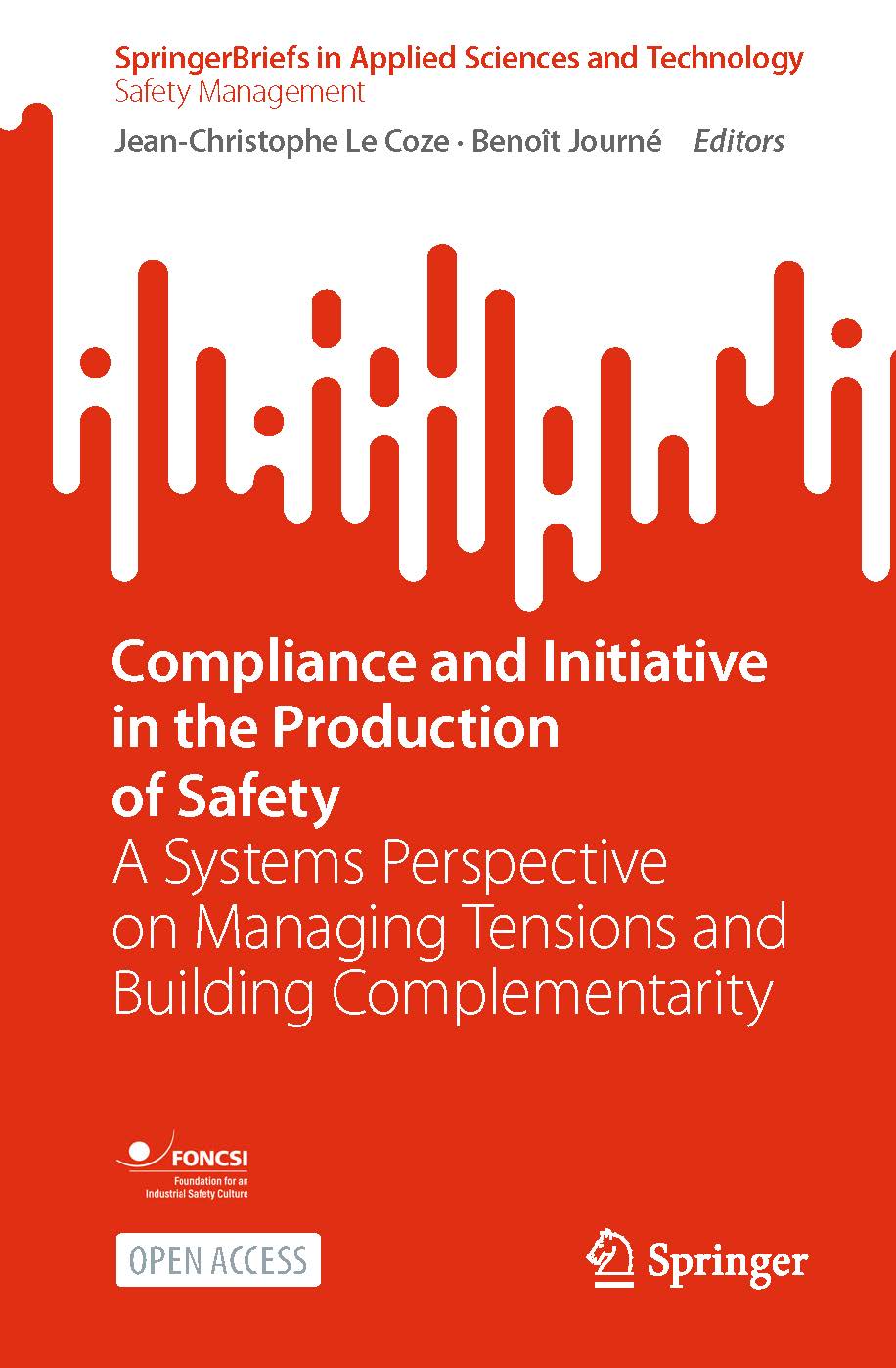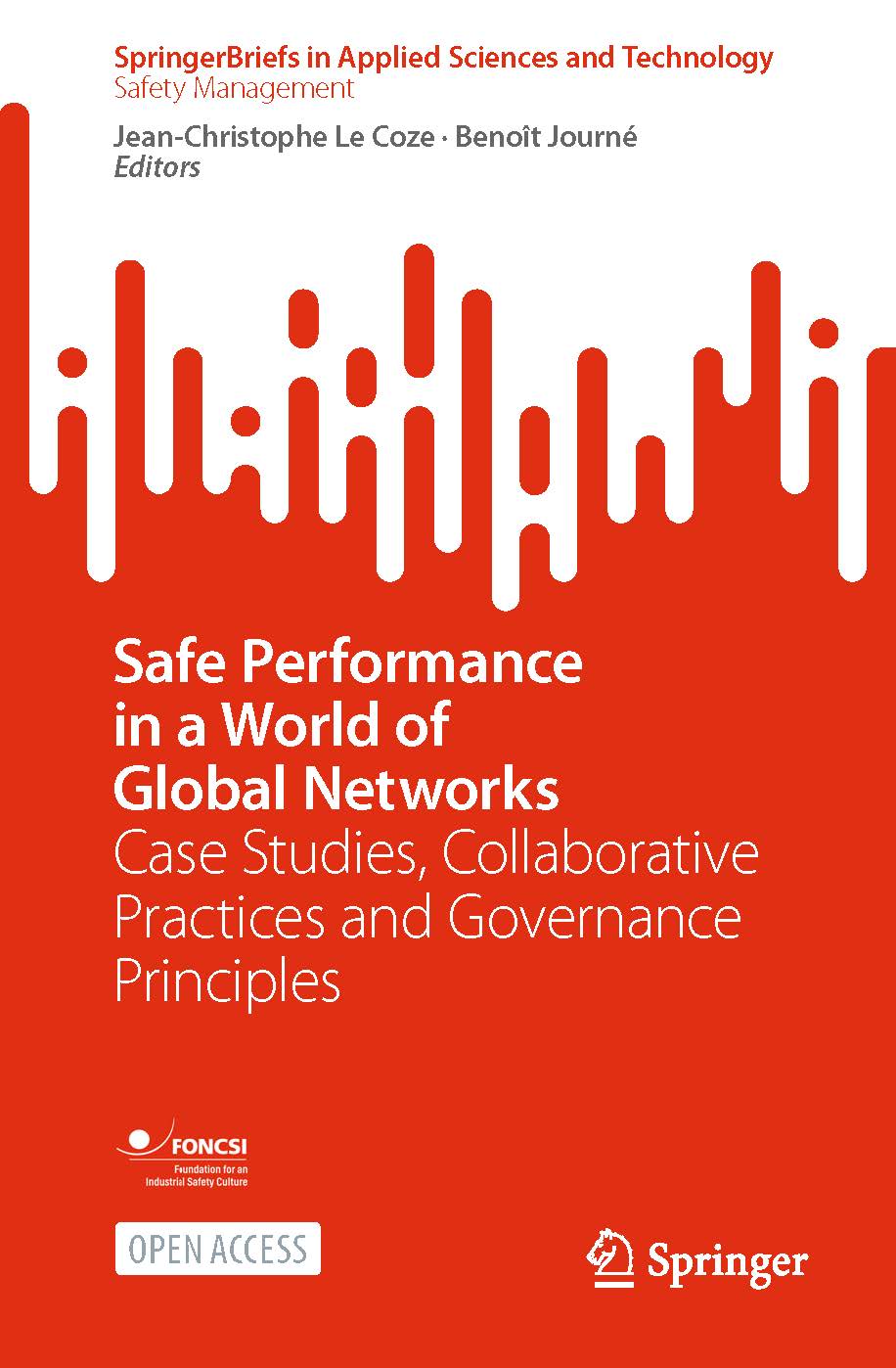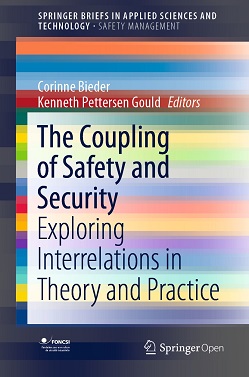SpringerBriefs in Safety Management
 This series weaves together insights from multiple scientific disciplines that shed light on safety management, including organization studies, psychology, sociology, economics, law and engineering. It explores novel topics related to industrial safety and technological risks, anticipating operational challenges in high-hazard industries and the societal concerns associated with these activities.
This series weaves together insights from multiple scientific disciplines that shed light on safety management, including organization studies, psychology, sociology, economics, law and engineering. It explores novel topics related to industrial safety and technological risks, anticipating operational challenges in high-hazard industries and the societal concerns associated with these activities.
These publications are by and for academics and practitioners (industry, regulators) in safety management and risk research. Relevant industry sectors include nuclear, offshore oil and gas, chemicals processing, aviation, railways, construction and healthcare. Some emphasis is placed on explaining concepts to a non-specialized but still academic audience, and the shorter format ensures a concentrated approach to the topics treated.
> Discover the series "SpringerBriefs in Safety Management" on the Springer website
An open access series
 Given FonCSI’s public-interest status, the books published in the "SpringerBriefs in Safety Management" series are all available as open access. Thus, the content of the entirety of this series is freely available. Simply download books, or individual chapters, from Springer's Internet platform.
Given FonCSI’s public-interest status, the books published in the "SpringerBriefs in Safety Management" series are all available as open access. Thus, the content of the entirety of this series is freely available. Simply download books, or individual chapters, from Springer's Internet platform.
BOOKS
Climate Change and Safety in High-Risk Industries
Editors : Bieder, C., Grote, G., Weyer, J. (Eds.)
May 2024 - 98 pages

This open access book directs attention to the safety implications of disruptive, sustainability-driven changes in sociotechnical systems resulting from climate-change considerations in high-risk industries.
It addresses not only the dismantling of currently prevalent systems and structures and the achievement of a stable future state but also the management of processes for establishing new practices in a safe and reliable manner without undue interruption of important functions and services.
> Freely available online (PDF, ePub)
The Regulator–Regulatee Relationship in High-Hazard Industry Sectors
Editors : Journé(Eds.)
February 2024 - 114 pages

The relationship between regulating and regulated entities is important in ensuring that safety is not subordinated to other concerns and in maintaining public confidence. As a result, the brief addresses various pressures and trade-offs inherent in that relationship, trade-offs between such considerations as: cost of the oversight activity and its effectiveness; regulator independence and its level of competency and understanding of the risks involved; ability to provide advice on meeting regulatory goals and being able to criticize decisions made; and effectiveness and intrusion in operational activities.
> Freely available online (PDF, ePub)
Compliance and Initiative in the Production of Safety
Editors : Journé(Eds.)
February 2024 - 87 pages
 This book addresses the idea that there are two ways to go about achieving a safe working environment. The text challenges the prevailing notion that compliance with a rule system, imposed from the top of an organization and designed to anticipate possible hazards in system operation, is really incompatible with the idea that the professional expertise of front-line workers is what promotes safe outcomes despite inevitable unanticipated perturbations. The contributors, drawn from academic and industrial backgrounds, demonstrate that rather than being at odds with each other, rules-compliance and proactivity are in fact complementary resources the coexistence of which increases safety. Furthermore, the implications of this approach extend beyond safety, being relevant to business performance, strategies for innovation and system resilience as well.
This book addresses the idea that there are two ways to go about achieving a safe working environment. The text challenges the prevailing notion that compliance with a rule system, imposed from the top of an organization and designed to anticipate possible hazards in system operation, is really incompatible with the idea that the professional expertise of front-line workers is what promotes safe outcomes despite inevitable unanticipated perturbations. The contributors, drawn from academic and industrial backgrounds, demonstrate that rather than being at odds with each other, rules-compliance and proactivity are in fact complementary resources the coexistence of which increases safety. Furthermore, the implications of this approach extend beyond safety, being relevant to business performance, strategies for innovation and system resilience as well.
> Freely available online (PDF, ePub)
Safe Performance in a World of Global Networks
Editors : Journé(Eds.)
November 2023 - 106 pages
 This book provides an analytical and critical outlook, by leading scholars, of the impact of various trends in the quality of collaboration and resulting safety outcomes that arise from the evolution of traditional integrated production within a single firm into a complex web of partnerships and supply chains. In the face of increasing fragmentation within industrial production and the associated rise in the complexity of inter-organizational communication and transaction, this book analyses causal factors such as cost pressures, globalization of demand, increasingly flexible resource allocation and work organization, changes in legal liability and the possibilities afforded by information technology.
This book provides an analytical and critical outlook, by leading scholars, of the impact of various trends in the quality of collaboration and resulting safety outcomes that arise from the evolution of traditional integrated production within a single firm into a complex web of partnerships and supply chains. In the face of increasing fragmentation within industrial production and the associated rise in the complexity of inter-organizational communication and transaction, this book analyses causal factors such as cost pressures, globalization of demand, increasingly flexible resource allocation and work organization, changes in legal liability and the possibilities afforded by information technology.
> Freely available online (PDF, ePub)
Visualising Safety, an Exploration
Editors : Reiman(Eds.)
September 2023 - 117 pages

This open access book explores the role visual tools and graphical models play in safety management. It explains the importance of visualising safety, for teaching concepts, communicating ideas to peers, and raising awareness of potential threats through posters.
It introduces graphical models which have been influential in promoting ideas of safety, and impacting the organisational design of safety mechanisms, including the Heinreich ‘safety pyramid’ and Reason’s ‘Swiss Cheese’.
> Freely available online (PDF, ePub)
Safety in the Digital Age
Editors : (Eds.)
September 2023 - 137 pages
This book deals with such issues as:
How can high-risk and safety-critical systems be affected by these developments, in terms of their activities, their organization, management and regulation?
What are the sociotechnical challenges of the proliferation of big data, algorithmic influence and cyber-security challenges in health care, transport, energy production/distribution and production of goods?
> Freely available online (PDF, ePub)
Managing Future Challenges for Safety
Editors: (Eds.)
October 2022 - 111 pages
What influence will ageing and lack of digital skills in the workforce of the occidental world have on safety culture? What are the likely impacts of big data, artificial intelligence and autonomous technologies on decision-making, and on the roles and responsibilities of individual actors and whole organizations? What role have human beings in a world of accelerating changes? What effects will societal concerns and the entrance of new players have on technological risk management and governance?
This book will interest and influence researchers considering the future effects of a number of currently developing technologies and their practitioner counterparts working in industry and regulation.
> Freely available online (PDF, ePub)
Contracting and Safety
Editors: Hayes (Eds.)
February 2022 - 116 pages
This book explores solutions to long-term public and worker safety when using contractors within engineering industries.
It provides advice on how organisations can maximise the benefits and minimise the safety risks.
> Freely available online (PDF, ePub)
The Coupling of Safety and Security
Editors:Bieder (Eds.)
Agust 2020 - 113 pages
 This open access book explores the synergies and tensions between safety and security management from a variety of perspectives and by combining input from numerous disciplines. It defines the concepts of safety and security, and discusses the methodological, organizational and institutional implications that accompany approaching them as separate entities and combining them, respectively. The book explores the coupling of safety and security from different perspectives, especially: the concepts and methods of risk, safety and security; the managerial aspects; user experiences in connection with safety and security.
This open access book explores the synergies and tensions between safety and security management from a variety of perspectives and by combining input from numerous disciplines. It defines the concepts of safety and security, and discusses the methodological, organizational and institutional implications that accompany approaching them as separate entities and combining them, respectively. The book explores the coupling of safety and security from different perspectives, especially: the concepts and methods of risk, safety and security; the managerial aspects; user experiences in connection with safety and security.
> Freely available online (PDF, ePub)
Human and Organisational Factors
Editors: (Eds.)
January 2020 - 138 pages
 This open access book addresses several questions regarding the implementation of human and organisational factors (HOF) so that recent improvements in industrial safety can be built upon. It addresses sources of frustration in senior management with high expectations of operational recommendations and disquiet on the part of HOF specialists struggling to have an impact on high-level decision making. The brief explores these issues with an emphasis on examples and lessons learned based on the experience of its authors, who come from different academic disciplines and various industrial sectors such as oil and gas, energy and transportation. It then offers some ways forward for a better consideration of HOF in hazardous companies with a view of promoting safety and facing challenges in a rapidly changing world.
This open access book addresses several questions regarding the implementation of human and organisational factors (HOF) so that recent improvements in industrial safety can be built upon. It addresses sources of frustration in senior management with high expectations of operational recommendations and disquiet on the part of HOF specialists struggling to have an impact on high-level decision making. The brief explores these issues with an emphasis on examples and lessons learned based on the experience of its authors, who come from different academic disciplines and various industrial sectors such as oil and gas, energy and transportation. It then offers some ways forward for a better consideration of HOF in hazardous companies with a view of promoting safety and facing challenges in a rapidly changing world.
> Freely available online (PDF, ePub)
Exploring Resilience
Editors: (Eds.)
December 2018 - 128 pages
 Resilience has become an important topic on the safety research agenda and in organizational practice. Most empirical work on resilience has been descriptive, identifying characteristics of work and organizing activity which allow organizations to cope with unexpected situations. Fewer studies have developed testable models and theories that can be used to support interventions aiming to increase resilience and improve safety. In addition, the absent integration of different system levels from individuals, teams, organizations, regulatory bodies, and policy level in theory and practice imply that mechanisms through which resilience is linked across complex systems are not yet well understood.
Resilience has become an important topic on the safety research agenda and in organizational practice. Most empirical work on resilience has been descriptive, identifying characteristics of work and organizing activity which allow organizations to cope with unexpected situations. Fewer studies have developed testable models and theories that can be used to support interventions aiming to increase resilience and improve safety. In addition, the absent integration of different system levels from individuals, teams, organizations, regulatory bodies, and policy level in theory and practice imply that mechanisms through which resilience is linked across complex systems are not yet well understood.
> Freely available online (PDF, ePub)
Safety Cultures, Safety Models
Editors: (Eds.)
September 2018 - 165 pages
 The objective of this book is to help at-risk organizations to decipher the “safety cloud”, and to position themselves in terms of operational decisions and improvement strategies in safety, considering the path already travelled, their context, objectives and constraints. What link can be established between safety culture and safety models in order to increase safety within companies carrying out dangerous activities? First, while the term “safety culture” is widely shared among the academic and industrial world, it leads to various interpretations and therefore different positioning when it comes to assess, improve or change it.
The objective of this book is to help at-risk organizations to decipher the “safety cloud”, and to position themselves in terms of operational decisions and improvement strategies in safety, considering the path already travelled, their context, objectives and constraints. What link can be established between safety culture and safety models in order to increase safety within companies carrying out dangerous activities? First, while the term “safety culture” is widely shared among the academic and industrial world, it leads to various interpretations and therefore different positioning when it comes to assess, improve or change it.
> Freely available online (PDF, ePub)
Risk Communication for the Future
Editors: (Eds.)
July 2018 - 175 pages
 The conventional approach to risk communication, based on a centralized and controlled model, has led to blatant failures in the management of recent safety related events. In parallel, several cases have proved that actors not thought of as risk governance or safety management contributors may play a positive role regarding safety. Building on these two observations and bridging the gap between risk communication and safety practices leads to a new, more societal perspective on risk communication, that allows for smart risk governance and safety management.
The conventional approach to risk communication, based on a centralized and controlled model, has led to blatant failures in the management of recent safety related events. In parallel, several cases have proved that actors not thought of as risk governance or safety management contributors may play a positive role regarding safety. Building on these two observations and bridging the gap between risk communication and safety practices leads to a new, more societal perspective on risk communication, that allows for smart risk governance and safety management.
> Freely available online (PDF, ePub)
Beyond Safety Training
Editors: Bieder, C., Gilbert, C., Journé, B., Laroche, H. (Eds.)
October 2017 - 160 pages
This book explores why, despite more and more resources devoted to safety training, expectations are not entirely met, particularly in the industrial sectors that have already achieved a high safety level. Its chapters reflect the viewpoints of experts from different disciplines, different countries, with experience in various industrial fields at the cutting edge of the theories and practices in terms of safety, professionalization and their relationships.
> Freely available online (PDF, ePub)
The Illusion of Risk Control
Editors: Motet, Gilles, Bieder, Corinne (Eds.)
September 2017 - 112 pages
This book explores the implications of acknowledging uncertainty and black swans for regulation of high-hazard technologies, for stakeholder acceptability of potentially hazardous activities and for risk governance. The conventional approach to risk assessment, which combines the likelihood of an event and the severity of its consequences, is poorly suited to situations where uncertainty and ambiguity are prominent features of the risk landscape. The new definition of risk used by ISO, “the effect of uncertainty on [achievement of] one’s objectives”, recognizes this paradigm change.
> Freely available online (PDF, ePub)




